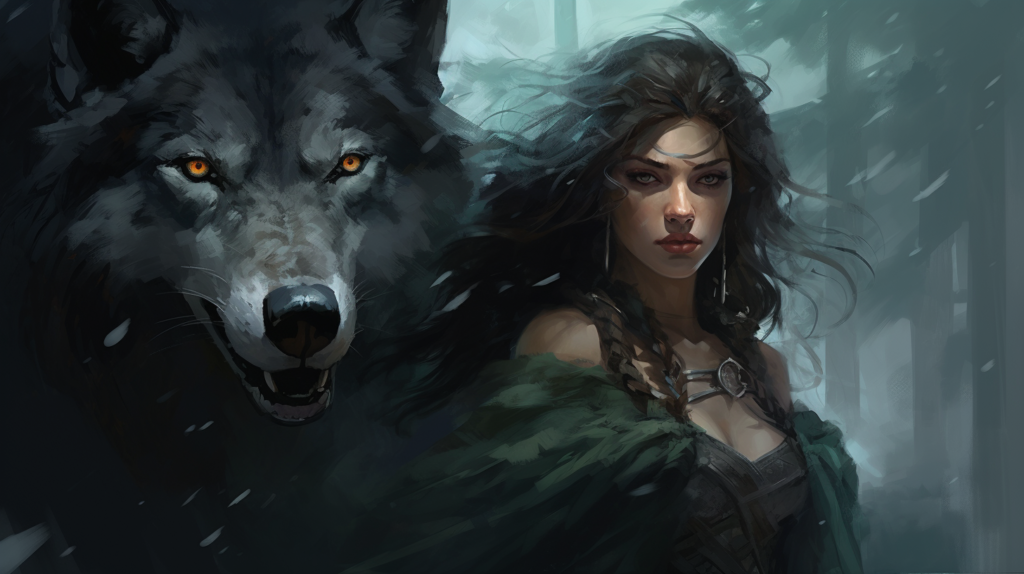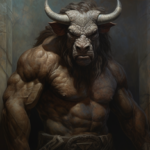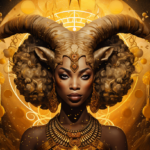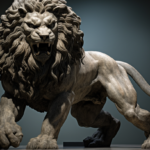Are you curious about Norse mythology and the powerful goddess of the north, Skadi? In this article, we’ll delve into her Nordic origins, uncover her role in the Norse pantheon, and explore her divine attributes.
Discover the depictions and symbols associated with Skadi, her relationships with other gods and mortals, and follow her captivating adventures across realms.
Learn about Skadi’s lasting impact on Norse culture and modern interpretations.
Get ready to immerse yourself in the fascinating world of Skadi, the goddess of the north.
Key Takeaways
- Skadi is the daughter of the giant Thiazi and sought revenge against the gods for her father’s death.
- Skadi embodies the fierce and untamed spirit of the North and rules over mountains, winter, and hunting.
- Skadi possesses exceptional hunting prowess and wields immense power over ice and snow.
- Skadi’s rocky marriage to Njord, her assistance to Thor, and her interactions with Loki shape her character and role in Norse mythology.
Origins of Skadi: Tracing Her Nordic Roots
To understand the origins of Skadi, the Norse Goddess of the North, you need to delve into the rich Nordic mythology. Exploring Skadi’s family lineage reveals her deep roots in the divine realm. Skadi is the daughter of the giant Thiazi, known for his immense strength and cunning. This connection to the giants gives Skadi a unique perspective, straddling the line between the divine and the mortal.
Skadi’s story also intertwines with other mythological figures, highlighting her importance in Norse mythology. One of her most notable connections is with the trickster god Loki. After the death of her father, Skadi sought revenge against the gods, who were responsible for his demise. As part of her quest, she demanded retribution and a god for a husband. Loki, always the negotiator, played a pivotal role in the arrangement. Though their union was short-lived, it solidified Skadi’s place among the gods.
Skadi’s connections to other mythological figures demonstrate her complex role in the Norse pantheon. She embodies the fierce and untamed spirit of the North, ruling over mountains, winter, and hunting. Her lineage and relationships reveal a goddess with deep ties to the divine and a relentless quest for justice.
Understanding Skadi’s origins sheds light on her significance in Norse mythology and the powerful role she played in the lives of the ancient Norse people.
Skadi’s Mythological Significance: Unveiling Her Role in Norse Pantheon
Unveil the profound role of Skadi in the Norse pantheon as she embodies the fierce and untamed spirit of the North, ruling over mountains, winter, and hunting. Skadi’s role in Norse mythology is of great significance, as she represents the power and independence of nature. Her connection to the mountains symbolizes her strength and endurance, while her association with winter highlights her ability to withstand harsh conditions. Additionally, her role as the goddess of hunting showcases her skill and prowess in the wilderness.
Skadi’s connections to other pantheons also contribute to her mythological significance. In Norse mythology, she’s the daughter of the giant Thiazi, and her marriage to the god Njord is a result of a peace treaty between the Aesir and the giants. This alliance between the gods and giants highlights Skadi’s ability to bridge the gap between different mythological realms, serving as a mediator and bringing balance to the Norse pantheon.
As we delve deeper into Skadi’s powers and abilities, we’ll explore her divine attributes and understand her true nature as a powerful and influential goddess in Norse mythology.
Skadi’s Powers and Abilities: Exploring Her Divine Attributes
Now let’s explore Skadi’s powers and abilities, delving into her divine attributes.
One of her notable abilities is elemental control, as she has command over the forces of nature, particularly the cold and frost.
Additionally, Skadi possesses exceptional hunting prowess, making her a skilled tracker and archer.
Skadi’s Elemental Control
You can explore Skadi’s elemental control and discover her divine attributes.
As the goddess of the North, Skadi wields immense power over ice and snow, harnessing the cold and frost to her will. Her control over these elements is unparalleled, allowing her to create blizzards and freezing winds with a mere wave of her hand.
Skadi’s connection to the mountains and wilderness further enhances her elemental control. She draws strength from the towering peaks and untamed wilderness, channeling their raw energy into her abilities. With every step she takes on the icy slopes and through the snowy forests, Skadi’s power grows, making her an unstoppable force of nature.
Embrace the chilling beauty of Skadi’s elemental control and witness the might of the goddess of the North.
Skadi’s Hunting Prowess
Skadi’s hunting prowess showcases her divine attributes, as she expertly navigates the treacherous landscapes of the North and uses her keen senses to track down her prey.
Skadi’s hunting techniques are a testament to her skill and agility. With her knowledge of the wilderness and her unmatched ability to blend in with her surroundings, she can move silently and undetected.
Skadi’s favored prey includes the majestic reindeer, elusive wolves, and powerful bears. She hunts with precision and patience, waiting for the perfect moment to strike.
Skadi’s keen eyesight allows her to spot her prey from great distances, while her heightened hearing allows her to detect even the faintest sounds. She moves swiftly and gracefully, embodying the spirit of the hunt and exemplifying her divine power over the wild.
Skadi’s Iconography: Depictions and Symbols Associated With Her
Associated with the goddess Skadi of Norse mythology are various depictions and symbols that provide insight into her character and role in the pantheon. Skadi’s presence can be found in Norse art, where she’s often depicted as a tall and fierce figure clad in fur and wielding a bow and arrow. These artistic representations highlight her hunting prowess and association with the wilderness.
Symbolism associated with Skadi’s iconography further emphasizes her connection to nature and the harsh, snowy landscapes of the North. The snow-covered mountains and icy cliffs often depicted alongside her symbolize her dominion over these rugged terrains. Additionally, Skadi is often shown accompanied by wolves, representing her affinity for wild animals and her role as a protector of the wilderness.
The inclusion of skis in Skadi’s iconography is another significant symbol. Skis weren’t only a practical necessity for traversing the snowy landscapes but also symbolized her independence and self-reliance.
Skadi’s iconography thus portrays her as a powerful and resilient goddess, embodying the untamed spirit of the North and reminding us of her importance in Norse mythology.
Skadi’s Relationships: Interactions With Other Gods and Mortals
Skadi has had interactions with multiple gods and mortals, shaping her relationships within Norse mythology. One notable relationship is her connection with Loki, the trickster god. In one myth, Skadi seeks revenge for the death of her father by demanding compensation from the gods. They agree to grant her a husband from their ranks, but she must choose him based solely on his feet. Skadi chooses the most beautiful pair, assuming they belong to Baldr. However, they belong to Njord, Loki’s father. This results in a rocky marriage between Skadi and Njord, as they can’t find common ground due to their differing natures.
Another significant interaction is Skadi’s encounters with Thor, the god of thunder. In the myth of Thrym’s theft, Thor’s hammer is stolen by the giant Thrym, who demands Freyja as a bride in exchange for its return. The gods plan to disguise Thor as Freyja and send him to Jotunheim to retrieve the hammer. Skadi plays a role in this plan, as she lends Thor her magical skis to help him travel swiftly. This demonstrates Skadi’s willingness to assist the gods and her connection with Thor.
Skadi’s Journey: Following Her Adventures Across Realms
As you delve into Skadi’s journey, you’ll discover her remarkable ability to hop between realms, traversing the vast landscapes of the Norse mythology.
From the icy mountains of Jotunheim to the enchanting forests of Alfheim, Skadi’s adventures take her to various realms, each with its own unique challenges and conquests.
Explore alongside Skadi as she conquers new territories and uncovers the secrets of the realms she encounters.
Skadi’s Realm-Hopping Feats
Embark on a thrilling journey as you witness the extraordinary realm-hopping feats of the powerful Norse goddess, Skadi. Through her adventures across realms, Skadi encounters various mythological beings, from giants and dwarves to gods and goddesses. Her realm hopping abilities allow her to traverse the realms effortlessly, forging alliances, gaining knowledge, and challenging her foes.
The significance of Skadi’s realm hopping abilities in Norse mythology is immense. It showcases her incredible power and connection to the supernatural world. Skadi’s ability to move between realms not only highlights her adaptability, but also symbolizes her role as a boundary-crosser and mediator between different realms and beings.
Her realm hopping adventures contribute to the overall narrative by adding depth and complexity to the Norse mythological universe, revealing the intricate relationships between various realms and creatures. Skadi’s realm-hopping feats are a testament to her strength, resourcefulness, and the boundless possibilities within Norse mythology.
Exploring Skadi’s Conquests
As you continue to delve into Skadi’s realm-hopping feats, you’ll now embark on a journey to explore her conquests and follow her adventures across the various realms of Norse mythology.
Skadi’s conquests were legendary, as she proved herself to be a formidable warrior and a force to be reckoned with. One of her most notable triumphs was her battle with the gods themselves.
Skadi sought revenge for the death of her father and demanded compensation. The gods, impressed by her strength and determination, agreed to a compromise. Skadi was given the choice to marry one of them, and she chose Njord, the god of the sea.
Through her conquests, Skadi not only gained respect and power, but she also left a lasting legacy as a symbol of strength and resilience in Norse mythology.
Skadi’s Legacy: Influence on Norse Culture and Modern Interpretations
Exploring Skadi’s legacy reveals her profound influence on Norse culture and modern interpretations. Here are three ways in which she’s left her mark:
- Skadi’s influence on Norse art and literature: Skadi’s character and stories have inspired numerous artistic and literary works in Norse culture. She’s often depicted in sculptures, paintings, and illustrations, showcasing her strength, beauty, and connection to the natural world. In literature, Skadi’s adventures and interactions with other gods and goddesses have been retold in sagas and poems, further solidifying her place in Norse mythology.
- The role of Skadi in modern paganism and neo-paganism: Skadi’s prominence in Norse mythology has led to her inclusion in modern pagan and neo-pagan practices. Many pagans and practitioners of Norse spirituality honor Skadi as a deity associated with winter, mountains, and hunting. She’s seen as a symbol of resilience, independence, and the power of nature. Some even invoke Skadi’s energy and attributes during rituals and ceremonies, seeking her guidance and strength.
- Skadi’s influence on gender roles and empowerment: Skadi’s character challenges traditional gender roles and norms. As a goddess associated with skiing, hunting, and winter sports, she defies the stereotypes of femininity and showcases the strength and capabilities of women. Skadi’s stories have become a source of inspiration for those seeking to break free from societal expectations and embrace their own power and independence.
Frequently Asked Questions
How Did Skadi’s Nordic Roots Influence Her Mythological Significance?
Skadi’s Nordic roots heavily influenced her mythological significance. Her connection to the cold and harsh North, along with her association with skiing and hunting, made her a powerful and revered goddess in Norse mythology.
What Are Some Lesser-Known Powers and Abilities of Skadi?
Shape shifting and mastery of winter are some of Skadi’s lesser-known powers and abilities. Embrace the mystery and explore the depths of her mythological significance through these unique traits.
What Are Some Symbols and Depictions Associated With Skadi?
Skadi’s symbols and depictions include ice and snow, a bow and arrows, mountain peaks, wolves, skis, and snowshoes. She represents winter, mountains, hunting, and revenge. She can shape shift, control animals, and is an expert archer.
How Did Skadi’s Relationships With Other Gods and Mortals Shape Her Story?
Skadi’s romantic relationships with Loki and Njord and her conflicts with Odin and Thor shaped her story. These interactions influenced her decisions and actions, ultimately defining her role as the fierce and independent goddess of the North.
How Did Skadi’s Adventures Across Realms Contribute to Her Overall Journey?
Skadi’s adventures across realms shaped her overall journey by allowing her to encounter other mythical beings and seek revenge against the gods. These encounters and pursuits added depth and complexity to her story.







